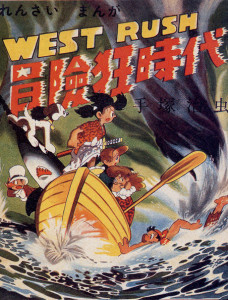Age of Adventure (Manga)
Also known as 冒険狂時代 (Boukenkyou Jidai)
| English Title: | Age of Adventure |
| In English? | Yes (digital) |
| Japanese Title: | 冒険狂時代 Boukenkyou Jidai |
| Type: | Ongoing Serial |
| Original run: | 1951/01 – 1953/08 |
| Published in: | Adventure King 冒険王 |
| Published by: | Akita Shoten |
| Volumes: | 1 MT-040 |
Age of Adventure (1951-53), also known as West Rush, was originally published in Akita Shoten’s monthly Adventure King from January 1951 to August 1953. It is partially based on Tezuka’s early amateur work Old Man’s Treasure Island, which he created in 1945.
What it’s about
In the year 1876, young Takanosuke Arashi, an envoy of the Edo government, is traveling by sea en route to the United States in order to deliver a secret message regarding US/Japan trade. In the stormy Caribbean Sea, the ship is attacked by pirates.
When their ship sinks, a group of travelers take refuge in a life-boat. The group includes Takanosuke; a pirate named Luigi Bampa; an old English Minister named Picard; a Hungarian princess named Maria along with her brother Carolinard; and a French gambler named Peter Lorre. The group is also joined by a strange little dog with four names – Pochi, Shiro, Pesu, and… Doggy.
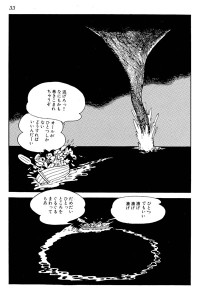
Hitch a ride on a tornado
While in the life-boat, the group is entrusted with half of Napoleon’s treasure map from the dying Picard. However, soon after the travellers are sucked up by a tornado waterspout and tossed “somewhere over the rainbow”, eventually raining down in the Nevada desert.
Now in the Wild West, Takanosuke meets the shady saloon-owner Hamegg and the story of Napoleon’s treasure soon has Takanosuke’s sword facing off against the Colt six-shooters of the Outlaw Wild Bill Hickock… with the mysterious Count Monte Christo thrown into the mix for good measure.
Before long though, the adventure takes off and becomes a hilarious romp around the globe, stretching from America to Morocco to Baghdad. Takanosuke fights pirates, cowboy gunmen, desert marauders, members of the French Foreign Legion, strange magicians, lions, poisonous snakes and even a giant spider. Napoleon’s treasure map changes hands several times and often it is the dog-of-many-names who saves the day.
Finally, in a classic Tezuka twist, in the end the maps leads to a treasure that is practically worthless… and Takanosuke’s trusty canine sidekick turns out to be an enchanted and cursed princess in disguise.
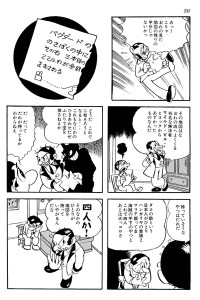
Hamegg up to no good
What you should know
Age of Adventure (1951-53) is one of Tezuka’s most frenetic action adventures. In fact, in the afterword to the Osamu Tezuka Complete Manga Works edition (MT-040), Tezuka himself says “in my own opinion, I have never done a series as poorly as this one” (1978, p. 214).
The reasons for this are varied, but related. First, and perhaps foremost, is it’s inception. In late 1950, the owner of Akita Shoten paid Tezuka a visit at his home in Takarazuka, with a request for a series to appear in Akita’s new publication, Adventure King. Never one to refuse an opportunity like that, Tezuka agreed, however there was just one problem. As he was already working on Jungle Emperor (1950-53) and just about to begin Ambassador Atom (1951), the series that would eventually become Astro Boy (1952-68), Tezuka found himself in unfamiliar territory… he was tapped out of ideas. After running into several dead-ends, he ultimately decided to return to the well, and retool and update his influential high-school amateur work, Old Man’s Treasure Island (1945).
This is was not without it’s challenges though. In Old Man’s Treasure Island (1945), the plot revolves around a silly private detective, French Inspector Ganimard, Sherlock Holmes, and the mysterious gentleman thief Arsène Lupin, all running around an island on a treasure hunt. However, the story took place in a much more modern era, and featured too much romance for a pure adventure series. This meant that several holes in the plot needed to be plugged, ultimately resulting in a dramatic restructuring of the overall story set-up.
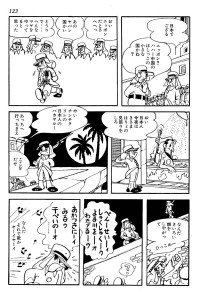
Takanosuke joins the French Foreign Legion
Tezuka’s primary answer to the problem was to start drawing from his vast knowledge of western culture – something quite exotic to his Japanese readership at the time. As such, the story features a wide array of characters, such as Wild Bill Hickok, Captain Kidd, John Silver, the Count of Monte Cristo, Dracula, Arsène Lupin… not to mention a cameo by John Wayne!
The plot problems were also exacerbated by Akita Shoten’s insistence on keeping the serialization going – turning Tezuka’s “treasure hunt in the Old West” tale into a globe-trotting razzmatazz extravaganza. This meant Tezuka had to start adding plot elements on an ad hoc basis, which ultimately resulted in parts of the story not making a lot of sense later on… A prime example being the dog-of-many-names suddenly turning out to be an enchanted Princess in disguise – something Tezuka had not initially planned for.
As with many of Tezuka’s works, the collected edition was subject to some retroactive tinkering and improvements. In this case it is most evident in the addition of a liberal dose of cinematic references. For example, when the ship carrying Takanosuke sinks, it suddenly sprouts the label “Titanic”. When a tornado picks up the lifeboat survivors, the English words “Over the Rainbow” magically appear – an obvious reference to Judy Garland’s famous theme song from The Wizard of Oz (1939). In the Nevada desert, Takanosuke lands in a wagon labeled “Road to…” – a reference to Bing Crosby’s and Bob Hope’s series of “Road to…” comedies, such as Road to Morocco (1942). It should also come as no surprise that there are references to both Treasure Island (1950) and the Douglas Fairbanks Middle-Eastern classic, The Thief of Baghdad (1924). Tezuka also manages to squeeze in a burial-in-the-desert scene that directly references the dramatic conclusion of the French film, Manon (1949) by Director Henri-Georges Clouzot. Finally, Tezuka riffs on the last scene of Charlie Chaplin’s classic short A Dog’s Life (1918), by having Takonosuke and the dog walk off into the sunset together.
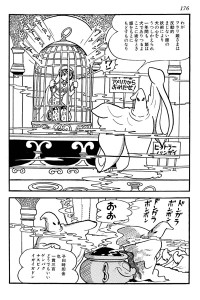
Ancient mystics at work
Also, in typical Tezuka humorist style, Hamegg gets to do his best Captain Haddock (of Hergé’s Tintin fame) impression by launching into a nonsensical English curse, “Paramount! RKO Radio! Republic! Universal 20th Fox!!”
Finally, it is also interesting to note that the hero’s name was originally intended to be Kazenosuke Arashi, but Akita editors inexplicably changed the Japanese character in his name from 風 [kaze] meaning “wind” to 凧 [tako] meaning “kite”, and so Tezuka elected to just go with the flow and changed the character’s name to Takonosuke Arashi for consistency… even though he still liked his original, more poetic, name better.
Where you can get it
In 2015 as part of DMP’s Digital Manga Guild initiative, Age of Adventure (1951-53) was published in English as a digital-only release. It is available for legal download on the emanga.com website in a variety of popular reading formats (ePub, CBR/CBZ, PDF, etc.).

